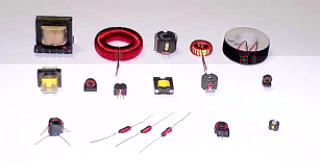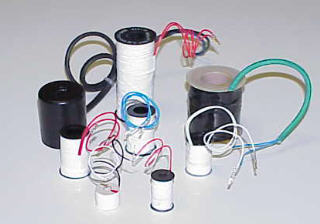



Visitors: Come In and have a look around! this is the place.
|
|
|
Hans R. Meyer P.E. Theory of Magnetic Cores & Magnetism Tutorial
Theory of Magnetic Cores & Magnetism Tutorial I f the bible were rewritten, the book of Genesis should start with: "In the beginning HE created the electron. " Lets’ call it here the e- !The e- is the most important thing in all of electrical engineering, despite the fact, that nobody knows what it really is. According to physicists it can be a particle as well as a Wave. Strange? How can anything be a particle and a wave at the same time ??? WRONG !!! NOT at the same time! If you show it being a particle, it forgets being a wave, if you show the wave character it does not show itself as a particle ! Einstein considers these things higher-dimensional (length,width,height,time and whatelse ??} If you project such a thingie into our 3 or 4 dimensional world, it will have multiple 3D or 4D projections which do not necessarily make sense to our thinking. In an atom the e- is said to orbit around the nucleus. (seemingly as a particle) but it is the wavefunction that tells the probability where it is at a certain moment. ONLY the probability, because Heisenberg says that location and speed can only be determined together with a certain minimum error, In other words: If you know where it is, you cannot tell where it’s going, and if you know it’s speed, you cannot tell where it is……… e- has an electric charge, so it can be accelerated by a voltage (not only in a wire, but also in a vacuum (see CRT). It also has something physicists stupidly call "spin" which has nothing to do with it spinning around it’s axis.(What axis ????} That spin comes ONLY in 2 kinds, up and down. (referred to what ???) and has something to do with Magnetism, for which there is only a sketchy description as a condition of space that makes a compassneedle move. Also, you can NOT distinguish one e- from another, they are all the same and you can NOT label one e- such that it stands out from the others. No Way !!! If an e- moves, its charge moves and if a charge moves, that is called a current. No sense, asking, why the charge moves, it doesn’t matter! It takes 1.6E16 e- (yes, that’s 16 Zeroes after the One) every second to move past a certain point to make 1 Ampère !!! That’s a bunch !!! If that Amp flows for one second into a 1 Farad Capacitor (A big one !) it raises The Voltage on the capacitor by one Volt. An Amp flowing a sec long is called a Coulomb.[Cb](That’s charge). And 1 Cb into 1 F makes 1V. (1 Cb into 1 µF would make 1 MV, keep fingers off ! If a current flows, all the tiny magnets of the e-‘s line up to add together to a much bigger Magnetic field which does NOT move, but stands still as long as the current keeps flowing unchanged. If the current flows in a wire, that field wraps itself around the wire and gets weaker, the farther away from the wire you go to measure it. And if you flow the current through a turn of wire and stick a magnetic material into the center, this core will concentrate the fields along its length which is perpendicular to the plane of the turn. (Magnetic field is always @ 90º to the direction of the current) . Unfortunately, the core does not catch ALL of the field, some squeezes through between the turn and the core and that part is called leakage flux. (There is no such thing as an insulator for magnetism). You run that wire around twice, you have 2 turns. But, since you cannot label individual e-‘s , you cannot label individual currents, so, the field sees 2 currents of the same strength and gets twice as strong, even if the 2 currents come from different sources! So, the important quantity is NOT Amps or Turns, it is Ampereturns (AT}and the field sums up all the contributing AT’s. And the core concentrates this field and kind of multiplies it by the permeability [µ] of the core material and the result is the active field in the device. This goes on until the AT’s are so high that the material reaches saturation and says: Yechch, I can no more!!! Then the leakage increases because the excess field now bypasses the core and any further increase of AT’s is useless for most practical purposes. The magnetization in the core is the Gausses [G] and it gets higher as the AT’s increase and lower as the cross-section of the core increases and as the magnetic pathlength of the core increases. So another important parameter for the Gausses is the AT’s per square inch of core! But, the length of the magnetic path in the core comes into play too, so first you have Amperes per meter which times a weird factor become Oersteds.(Oe). And the Oersteds multiplied by the effective permeability of the core become the Gausses. Naturally in their infinite wisdom, the standards people could not leave well enough enough, so they screwed up systems and we have Webers and Teslas and other new (old) names around, but just let’s be happy with Oe & G . (The old mho is now a Siemens but who uses that ???). The magnetic material is such characterizes by the magnetization curve, where the x-axis is calibrated in Oe and the y-axis in G. So, if you have a completely demagnetized material, this curve starts at the Origin (0/0), rises linearly and then bends over and reaches a saturation value. This is the virgin curve.[Never thought there would be electrical or magnetic virgins….] . Now when you reduce the Oe to 0, the curve will NOT retrace but will cross the y Axes at a point above 0, so with 0 Oe there will still be some G left and that is the Remanence. The core stays slightly magnetic ! If you do that with a Cobalt steel or with Alnico or other selected materials, a lot of G’s will be left at the 0 Oe point and you have now a permanent magnet !! By the way, the tangent of the angle at which the virgin leaves the origin (if you plot it as a straight line) (G/Oe) is the initial permeability µsub0 and that’s what the manufacturer advertises since is higher than the µ anywhere else (despite the fact that in actual use it does not mean a thing) Now, if you start applying negative Oe’s (by reversing the current) the G’s will go down from the remanence point and will reach 0. The Oe needed to do that are called the coercive force. Go farther with you negative Oe’s and you will now trace a G/Oe curve in the third quadrant into saturation and back to a negative remanence value. Now your Oe’s must go positive again and you trace a G/Oe curve in the first quadrant and so on---and so on…. At any point of these curves , the steepness (which is the angle of the tangent to the curve at this point [dG/dOe] is the effective permeability at that point. But you will never get back to the virgin !!! But when you go into saturation, the curve has bent to almost parallel to the Oe axis so the G’s don’t increase much when the Oe’s increase so the perm tends to go to 0. (Really to 1, because that’s the perm of empty space, so, effectively, the core has disappeared, or you are now left with an air core which has a perm of very close to 1.) But, efficient cores have perms in the 1000’s or 10’000’s so the saturation point perm of 1 is so negligible, you may as well call it 0 and state that at saturation the perm disappears ! Hans R. Meyer P.E. Copyright of General Linear Systems |
|
*************************************************************************************************** General Linear Systems 4332 Artesia Blv. Fullerton Ca. 92833 Ph: 1 ( 714 ) 994 - 4822 Fax : 1 ( 714 ) 994 - 4823 Email us at: This E-mail Link Send mail to
coilwinding@earthlink.net with questions or comments about
this web site.
|